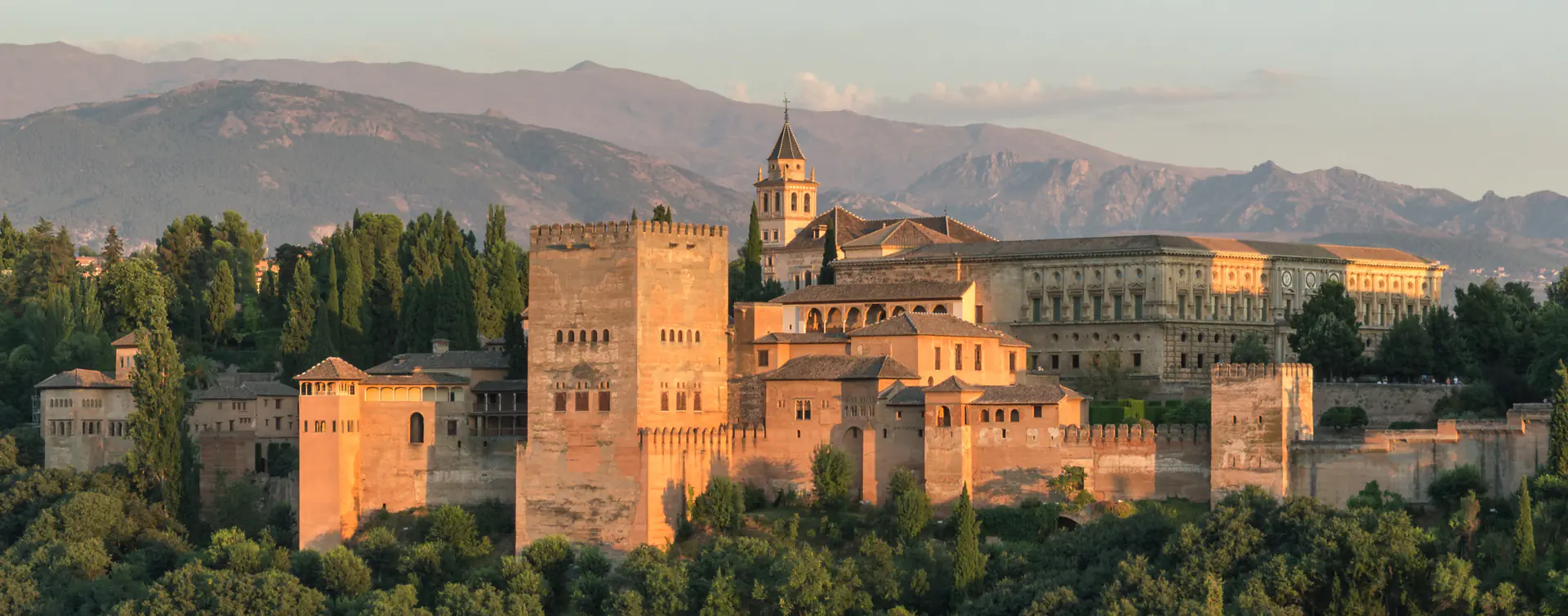
Alhambra Palace: Moorish Masterpiece of Nasrid Spain in Granada
Islamic Palatial City with Court of Lions and Generalife Gardens
About This Site
The Alhambra represents the pinnacle of Moorish architecture in Spain, showcasing extraordinary Islamic palatial design through magnificent Nasrid Palaces where intricate stucco decorations, geometric azulejo tilework, and revolutionary water engineering create sublime beauty. This UNESCO World Heritage complex encompasses the Court of Lions with marble fountain supported by twelve lions, Hall of Ambassadors with spectacular muqarnas dome ceiling, and Generalife summer palace with terraced gardens demonstrating sophisticated hydraulic systems. Founded in 1238 by Muhammad I Ibn al-Ahmar atop Granada's Sabika hill, the fortified palatial city reached its zenith during the 14th century under Nasrid rulers creating architectural masterpieces harmonising buildings with water and light. The Alcazaba fortress provides military protection.
Why It Matters
This palatial masterpiece demonstrates exceptional Islamic architectural achievement whilst preserving remarkable testimony to Nasrid culture during Muslim Spain's final centuries from 13th to 15th centuries. The Alhambra represents revolutionary integration of architecture, water engineering, and decorative arts establishing paradigms that profoundly influenced palace design and garden planning across Mediterranean, Islamic, and European architectural traditions worldwide.
Architectural Treasures of Nasrid Spain
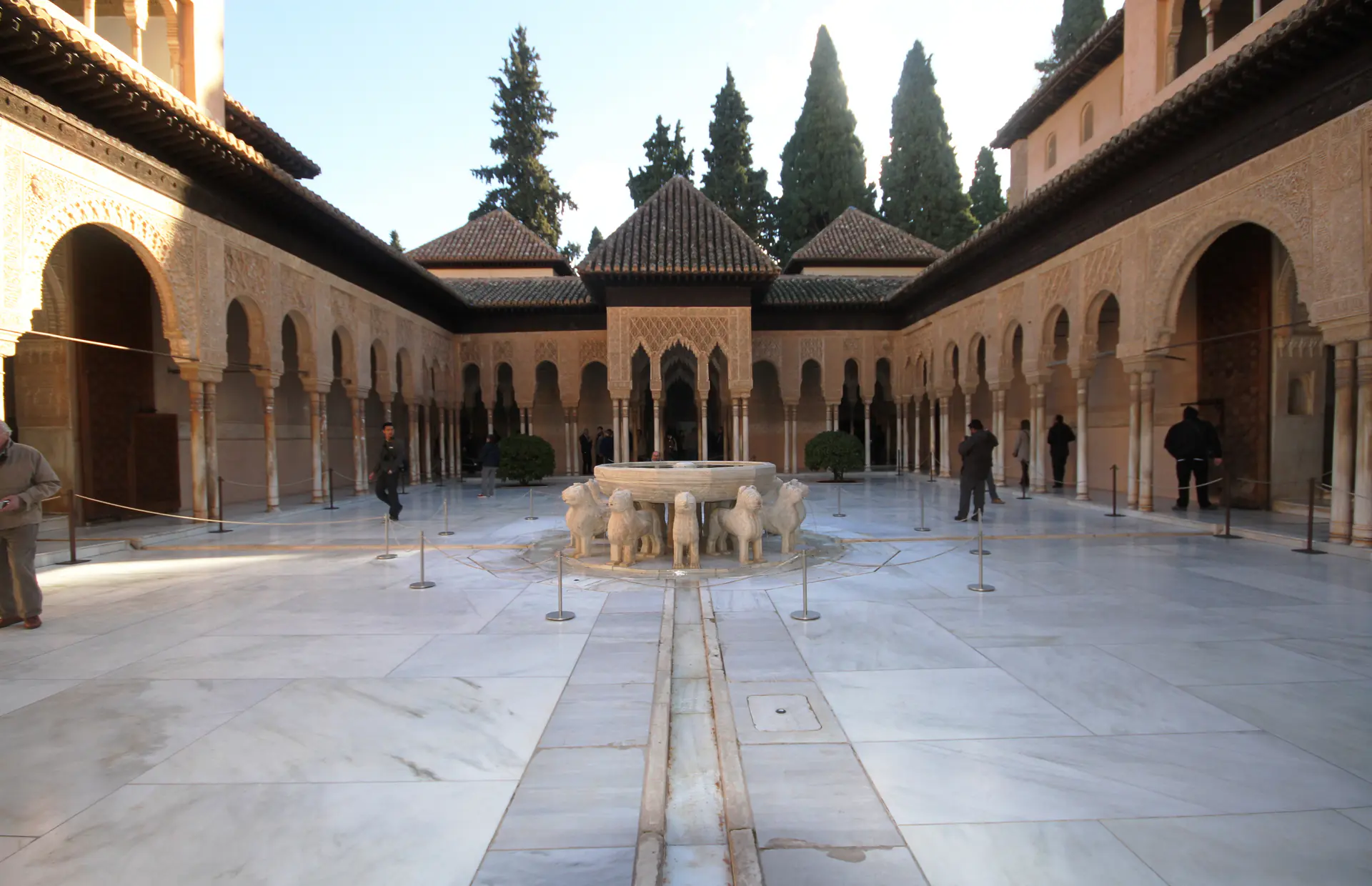
Court of Lions
The Alhambra's most celebrated courtyard represents the pinnacle of Nasrid architectural achievement through its iconic fountain supported by twelve marble lions surrounded by elegant arcades featuring 124 slender columns creating rhythmic visual harmony. Built by Sultan Muhammad V during the 14th century, the patio demonstrates sophisticated water engineering where channels flow from the central fountain through four directional rills representing rivers of paradise in Islamic tradition. The surrounding galleries feature intricate stucco decorations with geometric patterns whilst muqarnas domes cap corner pavilions creating stalactite-like structures of extraordinary complexity. This architectural masterpiece epitomises Nasrid artistic excellence through perfect integration of water, light, and decoration establishing paradigms for Islamic palace design that influenced architecture across Mediterranean and Islamic worlds.
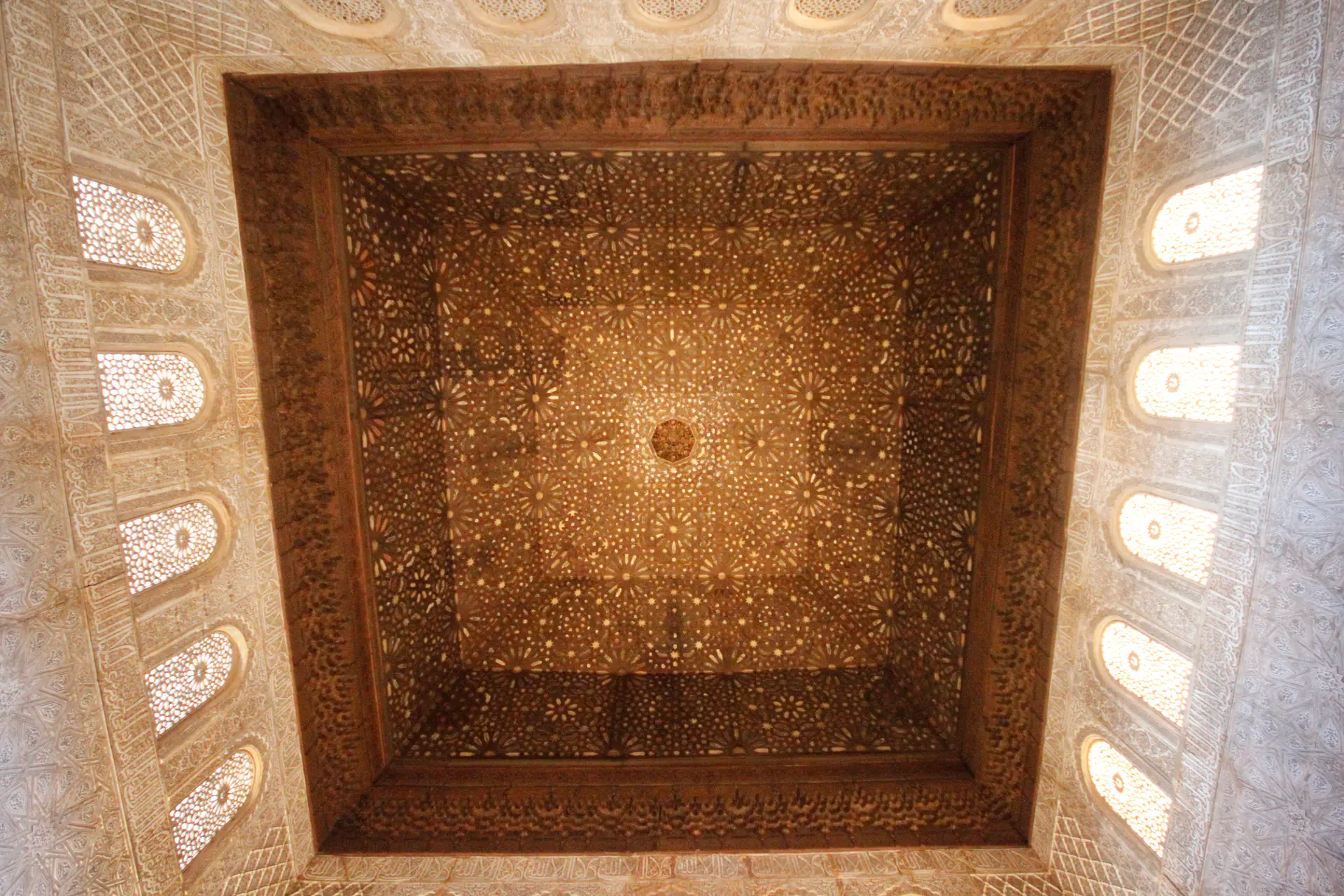
Hall of Ambassadors
The Alhambra's throne room represents the most magnificent chamber within Nasrid Palaces, featuring spectacular muqarnas dome ceiling composed of over 8,000 cedar wood pieces creating geometric star patterns symbolising seven heavens of Islamic cosmology. Built by Yusuf I in the 14th century, the hall served as royal reception chamber where sultans received foreign dignitaries beneath walls covered in intricate stucco plasterwork featuring geometric patterns, Arabic calligraphy, and elaborate azulejo tilework demonstrating exceptional artistic craftsmanship. Nine alcoves with horseshoe arches surround the chamber whilst windows provide strategic views across Granada, combining aesthetic beauty with defensive functionality. The exceptional acoustics enabled sultans to hear whispered conversations whilst maintaining ceremonial dignity during diplomatic audiences.
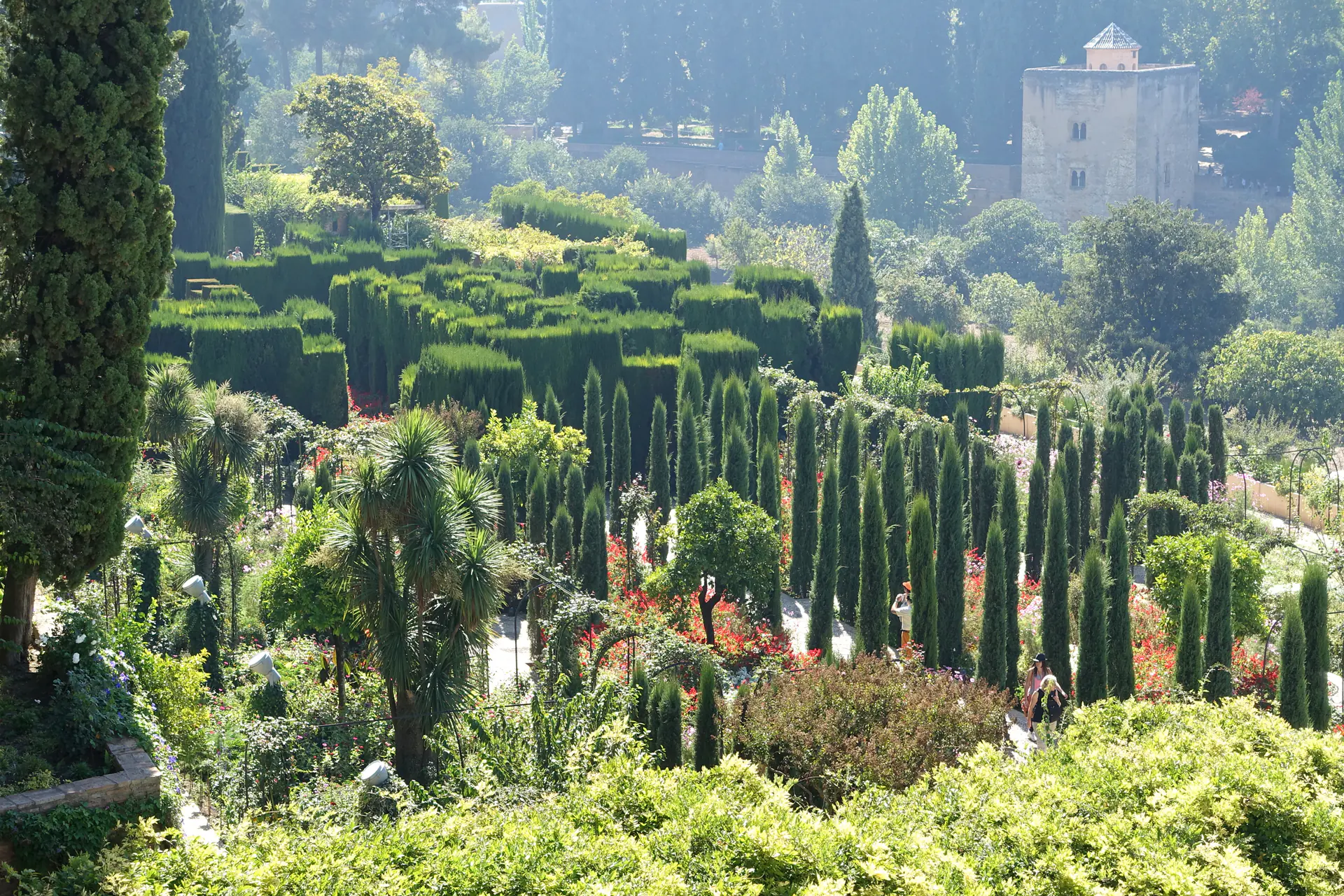
Generalife Gardens
The Generalife represents the Nasrid sultans' summer palace featuring magnificent terraced gardens demonstrating sophisticated Islamic hydraulic engineering through elaborate water channels, fountains, and irrigation systems creating verdant paradise above Granada. Constructed during 13th-14th centuries, the gardens showcase Moorish horticultural mastery with geometric plantings, fragrant flowers, fruit trees, and aromatic herbs whilst water features provide cooling effects and aesthetic beauty. The Patio de la Acequia features long water channel flanked by flowerbeds and fountains beneath arcaded galleries, whilst higher terraces offer spectacular panoramic views encompassing the Alhambra, Granada, and Sierra Nevada mountains. These gardens epitomise Islamic paradise tradition where architecture, water, vegetation, and landscape harmonise creating contemplative spaces that influenced garden design throughout Mediterranean and European traditions.
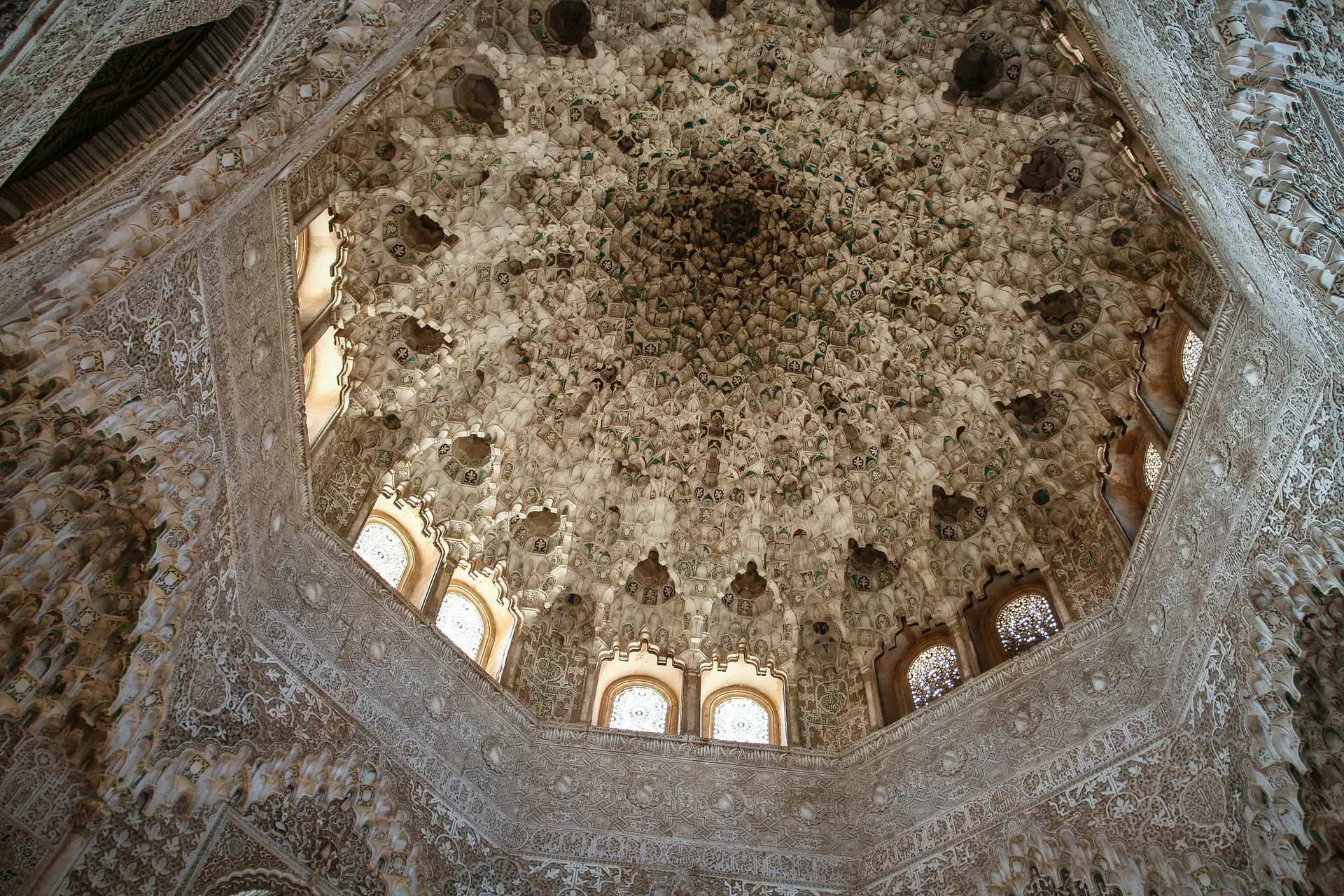
Muqarnas Decorative Vaults
The Alhambra showcases extraordinary muqarnas vaulting representing the pinnacle of Islamic decorative architecture through three-dimensional honeycomb structures composed of hundreds of individual stucco or wood pieces creating spectacular stalactite-like ceilings. These architectural marvels demonstrate exceptional mathematical precision where geometric principles generate complex patterns that appear to defy gravity whilst creating mesmerising visual effects as light plays across intricate surfaces. Nasrid artisans perfected muqarnas techniques creating domes, semi-domes, and transitional zones, particularly evident in Hall of Two Sisters where over 5,000 individual pieces form stellar pattern. The technique represents fusion of engineering, mathematics, and artistry establishing Islamic decorative tradition that influenced architecture across Muslim world whilst inspiring European Renaissance and contemporary designers.
Location & Planning
Located on Sabika hill in Granada, accessible via uphill walk, minibus C30/C32, or taxi. Euro (€) currency used throughout. Book tickets 3 months ahead through official website due to strict daily visitor limits.
Loading map...
Frequently Asked Questions
The Alhambra is a UNESCO World Heritage Moorish palace complex in Granada, Spain, exemplifying Islamic Nasrid architecture at its zenith. Built during 13th-15th centuries, it features the Court of Lions, intricate stucco decorations, geometric tilework, and revolutionary water engineering.
Muhammad I Ibn al-Ahmar founded the Alhambra in 1238 as royal residence and fortress. Successive Nasrid sultans, particularly Yusuf I and Muhammad V during the 14th century, expanded the complex creating magnificent palaces. After 1492, Catholic Monarchs and Charles V added Renaissance structures.
The Court of Lions represents the Alhambra's most iconic courtyard featuring central fountain supported by twelve marble lions surrounded by elegant arcades. Built by Muhammad V in the 14th century, it demonstrates sophisticated water engineering and geometric harmony epitomising Nasrid architectural excellence.
Walk uphill 20-30 minutes from Plaza Nueva, take C30 or C32 minibus to main entrance, or taxi directly to ticket office. Purchase tickets months ahead through official website as daily visitor numbers are strictly limited. Arrive 30 minutes before your Nasrid Palaces time slot.
October through March offers pleasant temperatures, fewer crowds, and better photography lighting during low season. Spring (April-May) provides beautiful garden blooms but increased visitors. Book tickets 3 months ahead regardless of season due to strict daily limits protecting the fragile historic structures.
All visitors require advance tickets purchased through official Alhambra website or authorised sellers. General admission includes Alcazaba, Nasrid Palaces, Generalife, and Palace of Charles V. Entry to Nasrid Palaces is timed; arriving late forfeits palace access whilst retaining other areas.
Wear comfortable walking shoes for extensive pathways and uneven surfaces. Bring sun protection including hat and sun cream for exposed areas. Layer clothing as temperature varies between shaded palace interiors and sun-exposed gardens. Modest dress recommended respecting the site's religious heritage.
The Alhambra demonstrates exceptional architectural genius through innovative integration of structures, water features, and decorative elements creating sublime aesthetic experiences. The palace exhibits extraordinary stucco artistry, geometric tilework, muqarnas domes, and hydraulic engineering representing the pinnacle of Islamic palatine architecture influencing design worldwide.
UNESCO World Heritage Criteria
Inscribed in 1984, this site meets 3 of UNESCO's 10 criteria for Outstanding Universal Value
Criterion (i): Masterpiece of human creative genius
The Alhambra represents a masterpiece of human creative genius through its exceptional Nasrid architecture featuring intricate stucco decorations, geometric tilework, and revolutionary water engineering. The palatial complex demonstrates extraordinary artistic achievement combining Islamic and Renaissance elements creating an architectural marvel that profoundly influenced subsequent design worldwide.
Criterion (iii): Testimony to cultural tradition
The Alhambra and Generalife bear exceptional testimony to Muslim Spain during the Nasrid dynasty from 13th to 15th centuries. The palaces preserve remarkable evidence of sophisticated Islamic culture, artistic excellence, and scientific knowledge during this final Muslim kingdom in Western Europe before Christian reconquest.
Criterion (iv): Outstanding architectural/technological ensemble
The palatial city represents an outstanding example of Nasrid palatine architecture showcasing the zenith of Moorish artistic achievement in Spain. The Alhambra demonstrates how Islamic architectural principles created harmonious integration between buildings, gardens, and water features establishing paradigms for palace design influencing architecture across cultures.
Historical Context
Nasrid Foundation (1238-1273)
Muhammad I Ibn al-Ahmar founded the Alhambra as fortified royal residence establishing Nasrid dynasty capital atop Granada's Sabika hill. Initial construction focused on Alcazaba fortress and water infrastructure whilst creating foundations for subsequent palatial development during following centuries.
Palatial Expansion (1273-1354)
Successive Nasrid sultans expanded the complex through palace construction, gardens development, and infrastructure improvements. Muhammad II and Muhammad III added significant structures whilst establishing the distinctive Nasrid architectural vocabulary combining stucco decoration, tilework, and water engineering defining the palace aesthetic.
Artistic Zenith (1354-1391)
Yusuf I and Muhammad V created the Alhambra's most magnificent structures including Court of Myrtles, Hall of Ambassadors, and Court of Lions. This golden age produced exceptional artistic achievements through intricate stucco work, geometric patterns, and revolutionary architectural integration demonstrating Nasrid culture at its zenith.
Late Nasrid Period (1391-1492)
Final Nasrid sultans maintained the palace whilst facing increasing Christian pressure during Reconquista. Despite political instability, artistic traditions continued with refinements to existing structures, though major construction ceased as the kingdom contracted under military threats from Catholic forces.
Christian Conquest (1492)
Catholic Monarchs Ferdinand and Isabella conquered Granada on 2 January 1492, ending nearly 800 years of Muslim rule in Iberia. The monarchs preserved the Alhambra whilst converting mosque to chapel, establishing royal residence within Nasrid palaces, and initiating gradual architectural modifications reflecting Christian sovereignty.
Renaissance Integration (1526-1568)
Emperor Charles V commissioned Renaissance palace within Alhambra complex, designed by Pedro Machuca featuring innovative circular courtyard within square structure. This addition demonstrated architectural transition whilst respecting Moorish heritage, creating dialogue between Islamic and Christian architectural traditions on Spanish soil.
Decline and Rediscovery (17th-19th Centuries)
The palace suffered neglect, occupation by homeless, and partial destruction during Napoleonic occupation when French forces exploded sections of Alcazaba. American writer Washington Irving's "Tales of the Alhambra" (1832) sparked Romantic interest, initiating conservation efforts and establishing the complex as essential destination for European travellers.
Modern Conservation (1870-Present)
Spanish government initiated systematic restoration programmes protecting architectural heritage whilst archaeological research revealed construction techniques and historical development. UNESCO World Heritage designation in 1984 strengthened international recognition whilst ongoing conservation balances preservation requirements with accommodating millions of annual visitors experiencing this architectural masterpiece.
Conservation & Protection
Current Conservation Status
Generally well-preserved through active conservation programmes, though facing significant pressures from mass tourism, environmental weathering, and structural deterioration requiring continuous monitoring and sophisticated restoration interventions balancing preservation with public access.
Conservation Challenges
- Mass tourism with 2.7 million annual visitors causing accelerated wear on fragile stucco decorations, tilework, and historic floors through foot traffic impacts
- Moisture infiltration and weathering from Granada's variable climate causing deterioration of stucco plasterwork, wood ceilings, and structural materials requiring constant monitoring
- Structural instability in certain areas including tower foundations and wall sections requiring engineering stabilisation whilst respecting original construction techniques and materials
- Air pollution and urban development pressures from expanding Granada affecting microclimate, visibility, and long-term preservation of external surfaces and decorative elements
- Balancing conservation requirements with visitor experience whilst maintaining strict daily limits protecting fragile interiors from overcrowding and environmental stress
Active Conservation Efforts
- Comprehensive conservation masterplan implemented by Alhambra and Generalife Trust regulating visitor access, establishing restoration priorities, and monitoring environmental conditions through advanced technology
- Systematic restoration of stucco decorations, tilework, and muqarnas domes using traditional materials and techniques whilst documenting original construction methods through detailed archaeological research
- Visitor management systems limiting daily numbers to 6,000, implementing timed entry for Nasrid Palaces, and establishing designated pathways protecting most vulnerable areas from excessive traffic
- Advanced monitoring systems tracking temperature, humidity, structural movement, and visitor impacts providing essential data for adaptive conservation strategies ensuring long-term preservation
- International collaboration with UNESCO, conservation specialists, and academic institutions providing technical expertise, funding support, and best practice guidance for protecting this exceptional cultural heritage
Image & Content Attribution
Research & Content Sources
Photography & Visual Media
Last updated: 9 October 2025